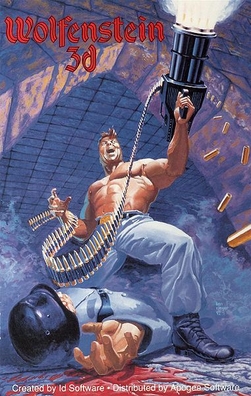Related Research Articles

Doom is a first-person shooter game developed and published by id Software. Released on December 10, 1993, for DOS, it is the first installment in the Doom franchise. The player assumes the role of a space marine, later unofficially referred to as Doomguy, fighting through hordes of undead humans and invading demons. The game begins on the moons of Mars and finishes in hell, with the player traversing each level to find its exit or defeat its final boss. It is an early example of 3D graphics in video games, and has enemies and objects as 2D images, a technique sometimes referred to as 2.5D graphics.

id Software LLC is an American video game developer based in Richardson, Texas. It was founded on February 1, 1991, by four members of the computer company Softdisk: programmers John Carmack and John Romero, game designer Tom Hall, and artist Adrian Carmack.

Quake is a first-person shooter game developed by id Software and published by GT Interactive. The first game in the Quake series, it was originally released for MS-DOS, Microsoft Windows and Linux in 1996, followed by Mac OS and Sega Saturn in 1997 and Nintendo 64 in 1998. In the game, players must find their way through various maze-like, medieval environments while battling monsters using an array of weaponry. Quake takes inspiration from gothic fiction and the works of H. P. Lovecraft.

Wolfenstein 3D is a first-person shooter video game developed by id Software and published by Apogee Software and FormGen. Originally released on May 5, 1992, for DOS, it was inspired by the 1981 Muse Software video game Castle Wolfenstein, and is the third installment in the Wolfenstein series. In Wolfenstein 3D, the player assumes the role of Allied spy William "B.J." Blazkowicz during World War II as he escapes from the Nazi German prison Castle Wolfenstein and carries out a series of crucial missions against the Nazis. The player traverses each of the game's levels to find an elevator to the next level or kill a final boss, fighting Nazi soldiers, dogs, and other enemies with a knife and a variety of guns.
Commander Keen is a series of side-scrolling platform video games developed primarily by id Software. The series consists of six main episodes, a "lost" episode, and a final game; all but the final game were released for MS-DOS in 1990 and 1991, while the 2001 Commander Keen was released for the Game Boy Color. The series follows the eponymous Commander Keen, the secret identity of the eight-year-old genius Billy Blaze, as he defends the Earth and the galaxy from alien threats with his homemade spaceship, rayguns, and pogo stick. The first three episodes were developed by Ideas from the Deep, the precursor to id, and published by Apogee Software as the shareware title Commander Keen in Invasion of the Vorticons; the "lost" episode 3.5 Commander Keen in Keen Dreams was developed by id and published as a retail title by Softdisk; episodes four and five were released by Apogee as the shareware Commander Keen in Goodbye, Galaxy; and the simultaneously developed episode six was published in retail by FormGen as Commander Keen in Aliens Ate My Babysitter. Ten years later, an homage and sequel to the series was developed by David A. Palmer Productions and published by Activision as Commander Keen. Another game was announced in 2019 as under development by ZeniMax Online Studios, but was not released.

John D. Carmack II is an American computer programmer and video game developer. He co-founded the video game company id Software and was the lead programmer of its 1990s games Commander Keen, Wolfenstein 3D, Doom, Quake, and their sequels. Carmack made innovations in 3D computer graphics, such as his Carmack's Reverse algorithm for shadow volumes.

Alfonso John Romero is an American director, designer, programmer and developer in the video game industry. He is a co-founder of id Software and designed their early games, including Wolfenstein 3D (1992), Doom (1993), Doom II (1994), Hexen (1995) and Quake (1996). His designs and development tools, along with programming techniques developed by id Software's lead programmer, John Carmack, popularized the first-person shooter (FPS) genre. Romero is also credited with coining the multiplayer term "deathmatch".

Catacomb 3-D is a first-person shooter video game, the third in the Catacomb series, the first of which to feature 3D computer graphics. It was developed by id Software and originally published by Softdisk under the Gamer's Edge label, released in November 1991. The player takes control of the high wizard Petton Everhail, descending into the catacombs of the Towne Cemetery to defeat the evil lich Nemesis and rescue his friend Grelminar.
Tom Hall is an American game designer best known for his work with id Software on titles such as Doom and Commander Keen.

Carl Sanford Joslyn "Sandy" Petersen is an American game designer. He worked at Chaosium, contributing to the development of RuneQuest and creating the acclaimed and influential horror role-playing game Call of Cthulhu. He later joined id Software where he worked on the development of the Doom franchise and Quake. As part of Ensemble Studios, Petersen subsequently contributed to the Age of Empires franchise.
Doom, a first-person shooter game by id Software, was released in December 1993 and is considered one of the most significant and influential video games in history. Development began in November 1992, with programmers John Carmack and John Romero, artists Adrian Carmack and Kevin Cloud, and designer Tom Hall. Late in development, Hall was replaced by Sandy Petersen and programmer Dave Taylor joined. The music and sound effects were created by Bobby Prince.

Dennis Fong, better known by his online alias Thresh, is an American businessman and retired professional player of the first-person shooter video games Quake and Doom. He is a co-founder of Xfire, an instant messenger and social networking site for gamers, which was acquired by Viacom for US$102 million in April 2006. He also co-founded Lithium Technologies, a social customer relationship management (CRM) company. In his playing career his highest profile victory came in 1997 at the Red Annihilation Quake tournament, where he placed first and won id Software CEO John D. Carmack's Ferrari 328. Fong is recognized by the Guinness World Records as the first professional gamer.

Tim Willits is the former studio director, co-owner, and level designer of id Software. As of August 2019, Willits is the chief creative officer at Saber Interactive. He became a Director of 3D Realms with Saber Interactive’s acquisition of the company.

Masters of Doom: How Two Guys Created an Empire and Transformed Pop Culture is a 2003 book by David Kushner about video game company id Software and its influence on popular culture, focusing on co-founders John Carmack and John Romero. The book goes into detail about the company's early years, the success of their franchises such as Doom, and the dynamics between Carmack and Romero and their different personalities. The book also focuses on Romero's firing and the founding and the eventual collapse of his game studio Ion Storm.

Doom is an American media franchise created by John Carmack, John Romero, Adrian Carmack, Kevin Cloud, and Tom Hall. The series usually focuses on the exploits of an unnamed space marine operating under the auspices of the Union Aerospace Corporation (UAC), who fights hordes of demons and the undead to save Earth from an apocalyptic invasion.

Blackroom was a planned first-person shooter game from the independent studio Night Work Games, created by former id Software developers John Romero and Adrian Carmack. It was planned to be crowdfunded on the Kickstarter platform, but the crowdfunding campaign was cancelled in April 2016. The game was set to launch during the winter quarter of 2018. In 2023, it was confirmed to be cancelled.

Commander Keen in Invasion of the Vorticons is a three-part episodic side-scrolling platform video game developed by Ideas from the Deep and published by Apogee Software in 1990 for MS-DOS. It is the first set of episodes of the Commander Keen series. The game follows the titular Commander Keen, an eight-year-old child genius, as he retrieves the stolen parts of his spaceship from the cities of Mars, prevents a recently arrived alien mothership from destroying landmarks on Earth, and hunts down the leader of the aliens, the Grand Intellect, on the alien home planet. The three episodes feature Keen running, jumping, and shooting through various levels while opposed by aliens, robots, and other hazards.

Commander Keen in Aliens Ate My Babysitter is a side-scrolling platform video game developed by id Software and published by FormGen in December 1991 for DOS. It is the seventh episode of the Commander Keen series, though it is numbered as the sixth, as Commander Keen in Keen Dreams is outside of the main continuity. The game follows the titular Commander Keen, an eight-year-old child genius, as he journeys through an alien world to rescue his kidnapped babysitter. The game features Keen running, jumping, and shooting through various levels while opposed by aliens, robots, and other hazards.

Romero Games Ltd. is an Irish independent video game development studio that was established on 11 August 2015 by husband-and-wife team John Romero and Brenda Romero and is located in Galway, Ireland. This is the ninth game studio Romero has established in his career, and currently it has released four titles.
References
- 1 2 Kushner, David (2003). Masters of Doom: How Two Guys Created an Empire and Transformed Pop Culture . New York: Random House. p. 77. ISBN 0-375-50524-5.
- ↑ Goninon, Mark (February 11, 2015). "Where are they now? - Adrian Carmack". Choicest Games. Archived from the original on July 4, 2018. Retrieved July 4, 2018.
- ↑ "We Play Doom with John Romero". IGN . December 30, 2013. Archived from the original on July 15, 2015. Retrieved June 2, 2015.
- ↑ "[Adrian] Carmack Sues id Software". Eurogamer . September 28, 2005. Archived from the original on March 4, 2016. Retrieved June 2, 2015.
- ↑ Lyons, Tom (September 23, 2014). "'Doom' game creator buys Heritage resort". The Irish Times . Archived from the original on December 22, 2015. Retrieved December 18, 2015.
- ↑ Machkovech, Sam (April 25, 2016). "John Romero, Adrian Carmack announce new video game and not much else". Ars Technica . Archived from the original on April 26, 2016. Retrieved April 25, 2016.
- ↑ Fields, Sarah (April 30, 2016). "Romero's Blackroom Kickstarter Cancelled, Demo in Development". Game Rant. Archived from the original on January 11, 2018. Retrieved January 10, 2018.
- ↑ Glixel, David Kushner (May 27, 2016). "Life After 'Doom': Creators of Era-Defining Game Speak". Rolling Stone . Archived from the original on July 4, 2018. Retrieved July 4, 2018.
- ↑ McWhertor, Michael (April 29, 2016). "Romero and Carmack pull their Kickstarter campaign for new FPS Blackroom". Polygon . Archived from the original on June 26, 2019. Retrieved June 26, 2019.